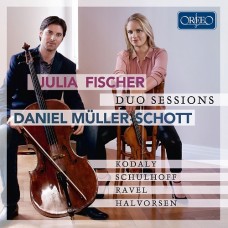您的購物車沒有添加專輯!
搜尋
小提琴與大提琴二重奏 (茱莉亞.費雪, 小提琴 / 丹尼爾.穆勒-修特, 大提琴) Duo Sessions: Julia Fischer & Daniel Müller-Schott
專輯編號: C902161
專輯類型: 單CD
發行年份: 2016
國際條碼: 4011790902128
音樂家:
庫存狀態: 目前無庫存
這張專輯收錄的四首曲目可說相當少見,但某方面來說也不算稀少。怎麼說呢?一來是特地寫給小提琴與大提琴兩種樂器合作的樂曲,說起來並不算多,自然錄音也是有限;但從另個角度來看,在這些有限的錄音當中,卻是每張幾乎都會一次包辦這四首曲目,光從這點也可說明這些樂曲的重要性,但你可能很難想像它們幾乎都是當代作品:高大宜1914、拉威爾的1922、舒霍夫的則是1925年完成。
雖然當時很少有人將這三首作品歸類在前衛藝術,但至少它們的調性在使用上還算有所關聯,樂曲中處處瀰漫著全新的精神:以前所未有的形式和表現方式探求所有的可能性,而且樂於嘗試罕見的實驗性手法。
另一個值得注意的重點,這三首樂曲的音樂語彙各自以獨特的方式反映出作曲家的民族特質。拉威爾在營造細微朦朧耳語效果的同時,又能保有純然的法式幽雅;高大宜從民謠當中探索民族背景精神;舒霍夫則是堅持以複雜的複合節奏進行他的音樂實驗。
然而,說到這種寫給小提琴/大提琴組合的前瞻性作品,毫無疑問又可上推一個世代:亦即布拉姆斯1887年的雙協奏曲。茱莉亞.費雪和丹尼爾.穆勒-修特兩人正是因為在同上共演此曲而結為好友。事實上,兩位藝術家也希望能藉由這張專輯的發行紀錄過去這十年多來的合作歲月。就像每年新年音樂會結束後,總會來個拉黛茲基進行曲作為結尾,現在每當他們演完布拉姆斯的雙協奏曲之後,聽眾也培養出「接下來他們一定會演出哈佛生1894年改編自韓德爾的那首帕薩卡利亞舞曲」的默契。這首長達十多分鐘的二重奏,係挪威作曲家兼小提琴家約翰.哈佛生(1864-1935)將韓德爾的大鍵琴組曲裡的帕薩卡利亞舞曲單獨抽出改編而成,可以用小提琴、中提琴或是大提琴兩兩自由搭配。哈佛生巧奪天工地將原作澎湃的情感渲染力轉移至這兩種性格截然不同卻又互補的樂器,當然,最精彩的莫過於我們可以見識到茱莉亞.費雪和丹尼爾.穆勒-修特兩位青年才俊音樂家的過人天賦和豐富藝術性。
Duets for violin and cello are what might be called the lowest common denominator of sophisticated solo literature and chamber music. Much as each member of the present duo intensively cultivates the chamber music repertoire, they are both first and foremost soloists – and are bound to remain so in the extraordinary technical and musical challenges of this intermediate category. After the premiere of the Ravel sonata, a contemporary listener wittily pleaded for the publication of a reduced version for orchestra.
It is appropriate that the original works to be heard in this programme – and they are some of the most important works for this repertoire – were written surprisingly late, some of them a decade or more after the dawn of the Modern era: Kodaly 1914; Ravel 1922; Schulhoff 1925. Even if the three works can scarcely be regarded as avant-garde for their time, at least where their tonality is concerned, a new spirit is in the air: a freely ranging search on all levels for new forms and means of expression, coupled with a love of experimentation with extremely sparse scoring. It is also noteworthy that all three works succeed in their own way in reflecting national character in their musical idiom, as befitted an age of heightened awareness of nationhood in music as elsewhere. Ravel offers typical trompe-l'oreille subtlety while retaining immaculately groomed French elegance; Kodaly writes against a background of ethnological research in folk music; Schulhoff stands out for the way he experiments with complex combinations of rhythm.
The pioneering work in a distinctive violin-cello repertoire was surely written a generation earlier: Brahms's concerto for this "eight-stringed giant" of 1887. It was a performance of his work that brought our two soloists together on the concert platform for the first time, setting a pattern for the future. In fact, both artists wish this CD release to represent a record of their work together as a duo over the past ten years and more, as the two Munich musicians explain in an extended conversation with Meret Forster printed in the accompanying booklet. It is already the case that performances of the Brahms Double Concerto by our pair of soloists now almost inevitably lead the audience to expect the immortal Handel-Halvorsen Passacaglia of 1894 – a demand which is gladly met. This congenial enlargement by the Norwegian violinist and composer Johan Halvorsen (1864-1935) of a passacaglia from a Handel suite for harpsichord exists in various pairings of violin, viola and cello. It accentuates the infectious vigour of the original in a remarkably clever manner by its highly challenging but idiomatic transposition to two quite differently characterized and mutually supportive instruments.
Z. Kodaly: Duo op. 7 for Violin and Violoncello
E. Schulhoff: Duo for Violin and Violoncello
M. Ravel: Sonata for Violin and Violoncello (A la memoire de Claude Debussy)
J.A. Halvorsen: Passacaglia
編號 |
曲目 |
長度 |
作詞 |
作曲 |
演奏 |
樂團 |
演唱 |
指揮 |
試聽 |
|---|


